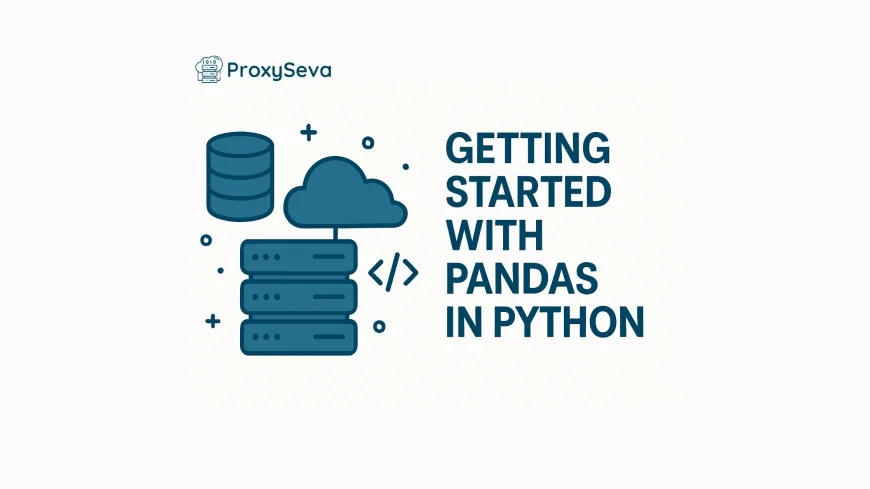Getting Started with Pandas in Python: A Beginner’s Step-by-Step Tutorial
Learn Pandas in Python with step-by-step examples. Clean, analyze, and structure scraped data efficiently using Pandas and proxies by ProxySeva.

-
Introduction
If you’re just starting with Python and web scraping, you’ve probably heard of Pandas. But what is Pandas, and why is it considered a must-have library for data analysis and manipulation? In this step-by-step guide, we’ll walk you through the fundamentals, helping you move from beginner to confident Pandas user. By the end, you’ll know exactly how Pandas simplifies working with structured and scraped data, making your projects faster, cleaner, and more efficient.
-
What is Pandas and Why Should You Use It?
Pandas is a powerful open-source Python library designed to make working with structured data simple and efficient. From analyzing spreadsheets to cleaning messy datasets or performing complex numerical operations, Pandas provides a wide range of tools to handle data seamlessly. Its intuitive syntax and flexibility have made it a must-have for anyone dealing with data in Python. For beginners, Pandas serves as the perfect starting point—helping you perform everything from basic manipulations to advanced transformations with ease.
-
Key Features of Pandas
-
Efficiently manage and analyze large datasets without performance issues.
-
Perform powerful operations such as filtering, grouping, merging, and reshaping data with minimal code.
-
Seamlessly integrate with popular Python libraries like NumPy, Matplotlib, and Scikit-learn for advanced analytics and visualization.
-
Provides a familiar, spreadsheet-like experience—making it a major upgrade from tools like Excel or Google Sheets when working with bigger and more complex data.
-
-
Installing Pandas: Quick and Easy
Before diving into its features, the first step is to get Pandas installed on your system. The process is simple and only takes a few commands. Here’s how you can set it up:
-
Install Python
Make sure Python is installed on your system. You can download it from python.org.
-
Install Pandas via pip
Open your terminal or command prompt and run the command:
pip install pandas -
Verify Installation
Once Pandas is installed, open your Python environment and run the following command:
If the version number appears without any errors, your installation is successful — and you’re ready to start working with Pandas!
-
-
Understanding Pandas Data Structures
The core of Pandas revolves around two fundamental data structures: Series and DataFrames. Here’s a simple breakdown of each:
-
Series
A Series in Pandas is a one-dimensional data structure that can store values of any type—such as integers, floats, strings, or even objects. You can think of it as being similar to a Python list or a single column in a spreadsheet. Each value in a Series is linked to an index, which makes data retrieval and manipulation fast and efficient.
Example:
Output:
-
DataFrame
A DataFrame in Pandas is a two-dimensional labeled data structure that organizes data into rows and columns—much like a table in a database or an Excel sheet. It provides powerful and flexible tools for handling, analyzing, and transforming structured data.
Example:
import pandas as pd
# Creating a simple DataFrame
data = {
'Name': ['Alice', 'Bob', 'Charlie', 'David'],
'Age': [25, 30, 35, 40],
'Country': ['USA', 'UK', 'Canada', 'Australia']
}
df = pd.DataFrame(data)
print(df)Output:
Name Age Country
0 Alice 25 USA
1 Bob 30 UK
2 Charlie 35 Canada
3 David 40 Australia
-
-
Reading Data with Pandas
A core part of data analysis is importing information from external sources such as CSV files, Excel sheets, or databases. With Pandas, this process is straightforward and efficient, allowing you to load and start analyzing data with just a single line of code.
-
Example 1: Reading CSV Files
df = pd.read_csv('data.csv')
print(df.head()) # Display the first 5 rows -
Example 2: Reading Excel Files
df = pd.read_excel('data.xlsx', sheet_name='Sheet1')
-
Example 3: Other Formats (SQL, JSON, etc).
Pandas also supports importing SQL queries, JSON files, and more
df = pd.read_json('data.json')
-
-
Performing Basic Operations in Pandas
After loading your dataset into a DataFrame, Pandas gives you a wide range of tools to explore, clean, and manipulate the data. Here are some of the most common and foundational operations you can start with:
-
Selecting Columns and Rows
# Select a single column
df['column_name']
# Select multiple columns
df[['col1', 'col2']] -
Filtering Data
# Filter rows where age > 25
filtered_df = df[df['Age'] > 25] -
Sorting Data
# Sort by Age in descending order
sorted_df = df.sort_values('Age', ascending=False)
-
-
Cleaning Data with Pandas
Real-world datasets are rarely perfect—they often contain missing values, duplicates, or inconsistent formatting. Pandas provides powerful functions to clean, organize, and prepare your data so it’s ready for accurate analysis.
-
Handling Missing Data
# Fill missing values with 0
df.fillna(0, inplace=True)
# Drop rows with missing values
df.dropna(inplace=True) -
Removing Duplicates
df = df.drop_duplicates()
-
-
Conclusion
Pandas is an essential tool for anyone working with scraped or large datasets. Raw web scraping output is often unstructured, noisy, and filled with gaps or duplicates—but with Pandas, you can transform that messy data into a clean, organized, and actionable format. Its powerful functions make it simple to filter, reshape, and analyze information, turning raw data into meaningful insights with minimal effort.
Mastering Pandas not only improves your efficiency but also gives you a strong foundation for advanced data analysis projects.
